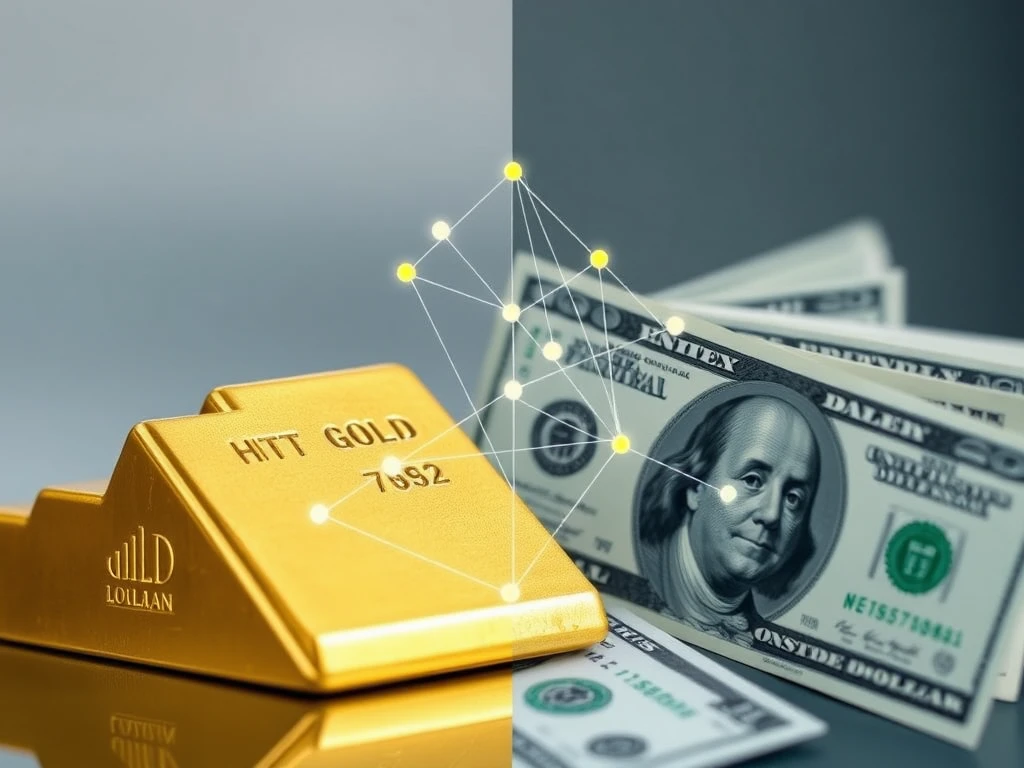Ultimate Guide: Gold-Backed vs USD-Backed Stablecoins – Key Differences Unveiled

In the ever-evolving world of cryptocurrency, stablecoins have emerged as a beacon of stability amidst the volatile waves. But not all stablecoins are created equal. Today, we’re diving deep into a fascinating showdown: gold-backed stablecoins versus USD-backed stablecoins. Which type reigns supreme? Which is the right choice for you? Let’s explore the key differences.
What are Gold-Backed Stablecoins and How Do They Function?
Imagine digital currency interwoven with the timeless allure of gold. That’s essentially what gold-backed stablecoins offer. These digital assets are designed to mirror the stable value of gold, a precious metal revered for centuries as a store of value. The concept isn’t entirely new, tracing back to the early days of crypto when innovators sought to inject reliability into the nascent digital currency landscape.
Here’s the core idea:
- Pegged to Gold: Each gold-backed stablecoin represents a specific amount of physical gold, like one token equaling 1 troy ounce (approximately 31.1 grams).
- Physical Backing: To ensure trust and security, a third-party custodian typically holds the actual gold reserves. For every token issued, the issuer must maintain an equivalent gold reserve.
- Price Alignment: The token’s market price closely tracks the spot price of gold. Buying a token is like buying gold at its current market rate. Conversely, in a failure scenario, token holders should theoretically be able to redeem their tokens for the equivalent gold value, often through fiat liquidation.
- Regulatory Classification: Depending on where you are, regulators might classify these as commodity-backed stablecoins or asset-referenced tokens (ARTs).
Notable examples in this category include Tether Gold (XAUT), Paxos Gold (PAXG), and Alloy (aUSDT). Interestingly, on April 1, 2025, Tether Gold (XAUT) was trading at $3,165, boasting a market cap around $780.3 million and a daily trading volume of $11.03 million.
The Powerful Advantages of Gold-Backed Stablecoins
Gold-backed stablecoins present a compelling fusion – the stability of gold combined with the agility of digital assets. They offer several advantages over traditional physical gold, thanks to their blockchain foundation:
- Flexible Alternative to Physical Gold: Think of these tokens as blockchain-based gold certificates. They’re a more efficient and flexible way to engage with gold than physically owning bullion.
- Instant Global Trading: Unlike physical gold, which can be cumbersome to move and trade, these tokens reside in crypto wallets, enabling instant, global transfers and trading with minimal fees.
- Access to DeFi: They unlock doors to decentralized finance (DeFi) applications, broadening their utility beyond just traditional gold investment.
- Enhanced Security: Physical gold is susceptible to theft, loss, or damage. Gold-backed stablecoins, secured by blockchain technology, can offer superior security.
- Programmability: Built on blockchains like Ethereum, these tokens are programmable. This means they can interact with smart contracts and decentralized applications (DApps), opening up innovative financial possibilities.
- Divisibility: Splitting physical gold is impractical. However, a single gold-backed stablecoin can be divided into minute fractions, all recorded immutably on the blockchain, making gold accessible to more people.
- Increased Accessibility: They democratize access to gold. While an entire ounce of gold might be expensive, you can easily purchase a fraction of a token, like 0.001, making gold ownership more attainable.
- Interoperability: Tokens issued on popular networks like Ethereum seamlessly integrate with a vast ecosystem of DApps, DeFi platforms, and wallets.
- Diversification Tool: Investing in gold-backed stablecoins is a unique way to diversify your portfolio, offering a hedge against currency devaluation.
What are USD-Backed Stablecoins, and How Do They Operate?
USD-backed stablecoins are the workhorses of the crypto stablecoin world. They are cryptocurrencies engineered to maintain a stable value by being pegged to the US dollar. The mechanism is straightforward: each token is backed by an equivalent amount of US dollars or highly liquid, cash-equivalent assets held in reserve by a financial institution or trust.
The core principle is trust and redeemability. For every USD-backed stablecoin in circulation, the issuer must hold a corresponding reserve to guarantee its value. This ensures that holders can always redeem their tokens for the equivalent dollar amount.
Popular examples include Tether (USDT), USDC (USDC), and Binance USD (BUSD). These crypto stablecoins are widely used for trading, payments, and within DeFi ecosystems. You can readily buy and sell them on major crypto exchanges like Binance or Coinbase. The process typically involves creating an account, verifying your identity, depositing fiat or crypto, and then selecting the stablecoin you wish to trade.
Interestingly, regulatory shifts, such as the EU’s Markets in Crypto-Assets Regulations (MiCA), are impacting the landscape. MiCA has led some exchanges to delist USDT and other non-compliant stablecoins, fostering a growing market for Euro-backed alternatives. However, USDC remains a prominent USD stablecoin alternative in the European region.
The Powerful Advantages of USD-Backed Stablecoins
USD-backed stablecoins are foundational to the crypto ecosystem, offering several compelling benefits by merging the reliability of fiat currency with the efficiency of blockchain technology:
- Steady Value: Unlike volatile cryptocurrencies, USD-backed stablecoins maintain a relatively stable value, making them ideal for payments, especially for goods and services.
- Liquidity and Accessibility: These crypto stablecoins enjoy widespread acceptance across crypto exchanges, payment platforms, and DeFi applications. Their high liquidity allows traders to move funds swiftly between assets without constantly converting back to fiat, reducing costs and delays.
- Transparency: Reputable issuers typically provide regular audits and reserve reports, allowing users to verify that actual USD holdings back each token. This transparency builds crucial trust.
- Fast, Low-Cost International Payments: Operating on blockchain, they facilitate rapid and inexpensive international payments, bypassing traditional banking systems. This makes them attractive for remittances and cross-border trade.
- Safe Haven in Market Downturns: During market volatility, USD-backed stablecoins provide stability. Investors often convert volatile crypto holdings into stablecoins to preserve value without exiting the crypto market altogether.
It’s important to acknowledge that even stablecoins can experience occasional “depegging” due to macroeconomic and microeconomic factors. Macro factors include broad economic shifts like inflation or interest rate hikes. Micro factors can involve issues specific to a stablecoin, such as collateral problems or liquidity crunches. The 2023 Silicon Valley Bank failure, which briefly depegged USDC due to $3.3 billion of its reserves being held there, serves as a stark reminder of these risks.
Did you know? Stablecoins come in four main types: fiat-collateralized, crypto-collateralized, algorithmic, and commodity-collateralized. Algorithmic stablecoins have largely fallen out of favor due to stability concerns.
Key Differences: Gold-Backed vs USD-Backed Stablecoins – The Decisive Comparison
While both gold-backed and USD-backed tokens are stablecoins, their fundamental differences lie in their backing assets, price stability characteristics, liquidity, adoption levels, and primary use cases. Let’s break down this stablecoin comparison:
| Feature | Gold-Backed Stablecoins | USD-Backed Stablecoins |
|---|---|---|
| Backing Asset | Physical gold reserves | US dollars, short-dated debt, and cash deposits |
| Price Stability | Value fluctuates with gold prices; potential for long-term appreciation, short-term volatility | 1:1 peg to USD; predictable short-term stability |
| Liquidity & Adoption | Lower liquidity, less integrated into DeFi | High liquidity, widely adopted in crypto ecosystem and DeFi |
| Use Cases | Value storage, inflation hedge, long-term investment | Everyday transactions, trading, financial services, value storage |
| Regulatory Considerations | Fewer specific regulations currently, subject to general financial regulations | Facing increasing specific regulations (e.g., GENIUS Act, STABLE Act in the US) |
Backing Asset: Physical Gold vs. Fiat Reserves
The most significant divergence in this asset-backed stablecoins debate is the underlying collateral. Gold-backed stablecoins are anchored to physical gold, typically at a set ratio. Conversely, USD-backed stablecoins are backed by reserves primarily composed of US dollars, short-term, highly liquid debt instruments, and cash deposits.
Price Stability: Long-Term vs. Short-Term
The price behavior differs significantly. Gold-backed stablecoins mirror the market price of gold, which, while exhibiting short-term volatility, historically tends to appreciate over the long term. USD-backed stablecoins, aiming for a 1:1 peg to the dollar, offer more predictable short-term stability. Their value is designed to remain constant unless external shocks, such as regulatory changes or reserve mismanagement, disrupt the peg.
Liquidity and Adoption: The DeFi Landscape
USD-backed stablecoins currently enjoy greater liquidity and broader acceptance within the cryptocurrency realm. They are deeply integrated into exchanges, payment systems, and DeFi applications, serving as essential tools for trading and lending. Their adoption extends beyond crypto-native spaces; some countries, particularly in Latin America like Bolivia, are even using USDC for everyday payments. Gold-backed stablecoins, while valuable for preserving wealth, have yet to achieve the same level of DeFi integration due to liquidity concerns.
Use Cases: Value Storage and Beyond
Gold-backed stablecoins are primarily positioned as a hedge against inflation and appeal to investors with a long-term growth perspective. USD-backed stablecoins, while also used for value storage, are more versatile. Their instant liquidity and ease of use make them ideal for everyday transactions, active trading, and a wide array of financial services.
Regulatory Considerations: Navigating Compliance
The regulatory landscape differs for these two types of stablecoins due to their distinct underlying assets. In the US, for example, specific legislative efforts like the Guiding and Establishing National Innovation for US Stablecoins Act (GENIUS Act) and the Stablecoin Transparency and Accountability for a Better Ledger Economy (STABLE) Act are emerging to regulate USD-backed stablecoins. As of March 31, 2025, no such specific regulations exist for gold-backed stablecoins, although they are generally expected to comply with existing banking and financial regulations.
Can Gold-Backed Stablecoins Overtake USD-Backed Coins? The Epic Stablecoin Battle
Could gold-backed stablecoins eventually surpass USD-backed coins in adoption? Arguments in their favor include gold’s inherent inflation resistance and long-term stability. As prominent Bitcoin advocate Max Keiser points out, gold commands greater global trust than the US dollar, especially among nations with geopolitical friction with the US.
However, the path to dominance is complex. While USD-backed stablecoins faced scrutiny under the Biden administration, they now appear to have gained favor with the US government under President Donald Trump. The current administration sees USD-backed stablecoins as a strategic asset to maintain the US dollar’s status as the world’s reserve currency. Support for acts like the GENIUS Act and the STABLE Act underscores this stance. Treasury Secretary Scott Bessent and Federal Reserve Governor Christopher Waller have both voiced support for stablecoins as a tool to reinforce US dollar hegemony.
Conversely, nations like Russia, China, and Iran, often at odds with the US, might lean towards gold-backed stablecoins to lessen reliance on the US dollar’s influence. Keiser suggests that China and Russia hold substantial unreported gold reserves, potentially exceeding 50,000 tons collectively, which could fuel the rollout of gold-backed stablecoins.
Tether’s introduction of Alloy (aUSDT) in June 2024, a gold-backed digital asset linked to Tether Gold (XAUT), signals the growing momentum behind bullion-backed stablecoins. Gold-backed stablecoins evoke parallels to the pre-1971 gold-backed US dollar era. XAUT’s impressive 15.7% year-to-date price increase hints at the growth potential of these assets.
While gold-backed stablecoins present a compelling alternative, the contest for supremacy between gold and USD-pegged stablecoins is far from settled. Geopolitical dynamics, evolving financial policies, and shifting market demand will all play crucial roles in determining the ultimate winner in this powerful stablecoin battle.








